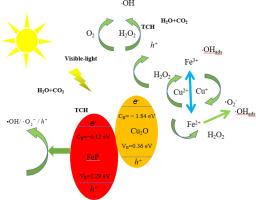磁性FeP/Cu2O异质结催化剂增强盐酸四环素的光fenton降解
IF 6.3
2区 材料科学
Q2 CHEMISTRY, PHYSICAL
引用次数: 0
摘要
抗生素污染造成重大的环境和健康风险,需要高效的废水处理技术。研究了FeP/Cu2O磁性复合材料在光- fenton法下对盐酸四环素的降解。通过化学沉淀法合成了该复合材料,并通过XRD、FT-IR、SEM和XPS对其进行了表征,证实了p-n异质结的成功形成。Fe1Cu1复合材料表现出优异的光- fenton性能,在可见光下60 min内对TCH的降解率达到94.7%,优于FeP和Cu2O。对催化剂用量、H2O2浓度、pH(2.2 ~ 11.2)、温度等关键因素进行了优化,证明了该体系具有广泛的适用性和稳定性。自由基捕获和EPR分析表明•OH是主要的活性物质。异质结增强了电荷分离和Fe3 + /Fe2 +的循环,而Cu2O提高了可见光利用率。经过5次循环后,该催化剂对TCH的降解效率保持在80%以上,并对共存的无机离子表现出较强的弹性。该研究为设计抗氧化、耐ph的废水抗生素降解催化剂提供了一种有前途的策略。本文章由计算机程序翻译,如有差异,请以英文原文为准。

Enhanced photo-fenton degradation of tetracycline hydrochloride using type-II magnetic FeP/Cu2O heterojunction catalysts
Antibiotic contamination poses significant environmental and health risks, necessitating efficient wastewater treatment technologies. The degradation of tetracycline hydrochloride (TCH) was investigated using a magnetic FeP/Cu2O composite via a photo-Fenton process in this study. The composite was synthesized through chemical precipitation and characterized by XRD, FT-IR, SEM, and XPS, which confirmed the successful formation of a p-n heterojunction. The Fe1Cu1 composite exhibited superior photo-Fenton performance, achieving 94.7% TCH degradation under visible light within 60 min, which outperformed its individual components, FeP and Cu2O. Key factors such as catalyst dosage, H2O2 concentration, pH (2.2-11.2), and temperature were optimized, which demonstrated the system's broad applicability and stability. Radical trapping and EPR analyses identified •OH as the dominant reactive species. The heterojunction was responsible for enhancing charge separation and Fe3⁺/Fe2⁺ cycling, while Cu2O improved visible-light utilization. The catalyst maintained over 80% degradation efficiency for TCH after five cycles and showed strong resilience to coexisting inorganic ions. This study provides a promising strategy for designing robust, pH-tolerant catalysts for antibiotic degradation in wastewater.
求助全文
通过发布文献求助,成功后即可免费获取论文全文。
去求助
来源期刊

Surfaces and Interfaces
Chemistry-General Chemistry
CiteScore
8.50
自引率
6.50%
发文量
753
审稿时长
35 days
期刊介绍:
The aim of the journal is to provide a respectful outlet for ''sound science'' papers in all research areas on surfaces and interfaces. We define sound science papers as papers that describe new and well-executed research, but that do not necessarily provide brand new insights or are merely a description of research results.
Surfaces and Interfaces publishes research papers in all fields of surface science which may not always find the right home on first submission to our Elsevier sister journals (Applied Surface, Surface and Coatings Technology, Thin Solid Films)
 求助内容:
求助内容: 应助结果提醒方式:
应助结果提醒方式:


